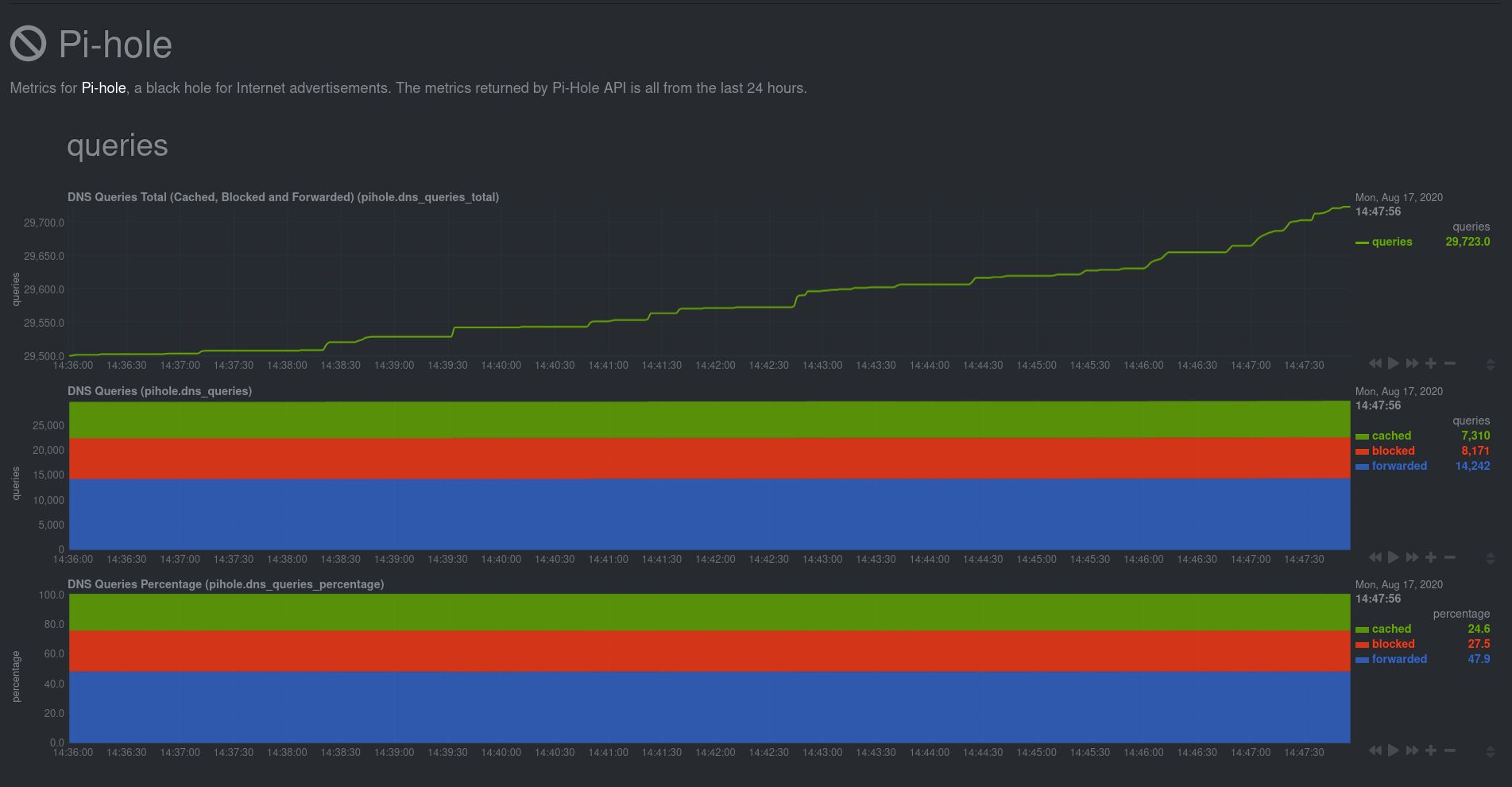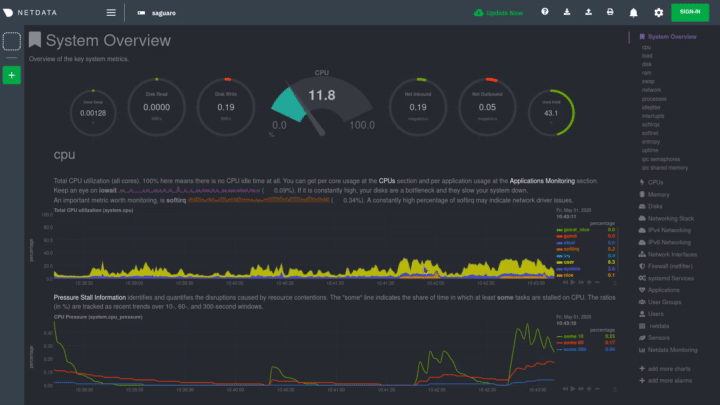mirror of
https://github.com/netdata/netdata.git
synced 2024-11-23 16:17:43 +00:00
* alerts-and-notifications broken link pass * category-overview-pages pass * dashboards and charts pass * deployment-guides pass * dev corner pass * exporting metrics pass * Netdata Agent pass * Netdata Cloud pass * observ centrl points pass * sec and priv design pass * final docs on docs/ folder * web server readme fix * fix broken link
121 lines
6.7 KiB
Plaintext
121 lines
6.7 KiB
Plaintext
<!--
|
|
title: "Monitor Pi-hole (and a Raspberry Pi) with Netdata"
|
|
sidebar_label: "Monitor Pi-hole (and a Raspberry Pi) with Netdata"
|
|
description: "Monitor Pi-hole metrics, plus Raspberry Pi system metrics, in minutes and completely for free with Netdata's open-source monitoring agent."
|
|
image: /img/seo/guides/monitor/netdata-pi-hole-raspberry-pi.png
|
|
custom_edit_url: https://github.com/netdata/netdata/edit/master/docs/guides/monitor/pi-hole-raspberry-pi.md
|
|
learn_status: "Published"
|
|
learn_rel_path: "Miscellaneous"
|
|
-->
|
|
|
|
# Monitor Pi-hole (and a Raspberry Pi) with Netdata
|
|
|
|
import { OneLineInstallWget } from '@site/src/components/OneLineInstall/'
|
|
|
|
Between intrusive ads, invasive trackers, and vicious malware, many techies and homelab enthusiasts are advancing their
|
|
networks' security and speed with a tiny computer and a powerful piece of software: [Pi-hole](https://pi-hole.net/).
|
|
|
|
Pi-hole is a DNS sinkhole that prevents unwanted content from even reaching devices on your home network. It blocks ads
|
|
and malware at the network, instead of using extensions/add-ons for individual browsers, so you'll stop seeing ads in
|
|
some of the most intrusive places, like your smart TV. Pi-hole can even [improve your network's speed and reduce
|
|
bandwidth](https://discourse.pi-hole.net/t/will-pi-hole-slow-down-my-network/2048).
|
|
|
|
Most Pi-hole users run it on a [Raspberry Pi](https://www.raspberrypi.org/products/raspberry-pi-4-model-b/) (hence the
|
|
name), a credit card-sized, super-capable computer that costs about $35.
|
|
|
|
And to keep tabs on how both Pi-hole and the Raspberry Pi are working to protect your network, you can use the
|
|
open-source [Netdata monitoring agent](https://github.com/netdata/netdata).
|
|
|
|
To get started, all you need is a [Raspberry Pi](https://www.raspberrypi.org/products/raspberry-pi-4-model-b/) with
|
|
Raspbian installed. This guide uses a Raspberry Pi 4 Model B and Raspbian GNU/Linux 10 (buster). This guide assumes
|
|
you're connecting to a Raspberry Pi remotely over SSH, but you could also complete all these steps on the system
|
|
directly using a keyboard, mouse, and monitor.
|
|
|
|
## Why monitor Pi-hole and a Raspberry Pi with Netdata?
|
|
|
|
Netdata helps you monitor and troubleshoot all kinds of devices and the applications they run, including IoT devices
|
|
like the Raspberry Pi and applications like Pi-hole.
|
|
|
|
After a two-minute installation and with zero configuration, you'll be able to see all of Pi-hole's metrics, including
|
|
the volume of queries, connected clients, DNS queries per type, top clients, top blocked domains, and more.
|
|
|
|
With Netdata installed, you can also monitor system metrics and any other applications you might be running. By default,
|
|
Netdata collects metrics on CPU usage, disk IO, bandwidth, per-application resource usage, and a ton more. With the
|
|
Raspberry Pi used for this guide, Netdata automatically collects about 1,500 metrics every second!
|
|
|
|

|
|
|
|
## Install Netdata
|
|
|
|
Let's start by installing Netdata first so that it can start collecting system metrics as soon as possible for the most
|
|
possible historic data.
|
|
|
|
> ⚠️ Don't install Netdata using `apt` and the default package available in Raspbian. The Netdata team does not maintain
|
|
> this package, and can't guarantee it works properly.
|
|
|
|
On Raspberry Pis running Raspbian, the best way to install Netdata is our one-line kickstart script. This script asks
|
|
you to install dependencies, then compiles Netdata from source via [GitHub](https://github.com/netdata/netdata).
|
|
|
|
<OneLineInstallWget/>
|
|
|
|
Once installed on a Raspberry Pi 4 with no accessories, Netdata starts collecting roughly 1,500 metrics every second and
|
|
populates its dashboard with more than 250 charts.
|
|
|
|
Open your browser of choice and navigate to `http://NODE:19999/`, replacing `NODE` with the IP address of your Raspberry
|
|
Pi. Not sure what that IP is? Try running `hostname -I | awk '{print $1}'` from the Pi itself.
|
|
|
|
You'll see Netdata's dashboard and a few hundred real-time, interactive charts. Feel free to explore, but let's turn our attention to installing Pi-hole.
|
|
|
|
## Install Pi-Hole
|
|
|
|
Like Netdata, Pi-hole has a one-line script for simple installation. From your Raspberry Pi, run the following:
|
|
|
|
```bash
|
|
curl -sSL https://install.pi-hole.net | bash
|
|
```
|
|
|
|
The installer will help you set up Pi-hole based on the topology of your network. Once finished, you should set up your
|
|
devices—or your router for system-wide sinkhole protection—to [use Pi-hole as their DNS
|
|
service](https://discourse.pi-hole.net/t/how-do-i-configure-my-devices-to-use-pi-hole-as-their-dns-server/245). You've
|
|
finished setting up Pi-hole at this point.
|
|
|
|
As far as configuring Netdata to monitor Pi-hole metrics, there's nothing you actually need to do. Netdata's [Pi-hole
|
|
collector](/src/go/plugin/go.d/modules/pihole/README.md) will autodetect the new service
|
|
running on your Raspberry Pi and immediately start collecting metrics every second.
|
|
|
|
Restart Netdata with `sudo systemctl restart netdata`, which will then recognize that Pi-hole is running and start a
|
|
per-second collection job. When you refresh your Netdata dashboard or load it up again in a new tab, you'll see a new
|
|
entry in the menu for **Pi-hole** metrics.
|
|
|
|
## Use Netdata to explore and monitor your Raspberry Pi and Pi-hole
|
|
|
|
By the time you've reached this point in the guide, Netdata has already collected a ton of valuable data about your
|
|
Raspberry Pi, Pi-hole, and any other apps/services you might be running. Even a few minutes of collecting 1,500 metrics
|
|
per second adds up quickly.
|
|
|
|
You can now use Netdata's synchronized charts to zoom, highlight, scrub through time, and discern how an anomaly in one
|
|
part of your system might affect another.
|
|
|
|

|
|
|
|
### Storing historical metrics on your Raspberry Pi
|
|
|
|
By default, Netdata allocates 256 MiB in disk space to store historical metrics inside the [database
|
|
engine](/src/database/engine/README.md). On the Raspberry Pi used for this guide, Netdata collects 1,500 metrics every
|
|
second, which equates to storing 3.5 days worth of historical metrics.
|
|
|
|
You can increase this allocation by editing `netdata.conf` and increasing the `dbengine multihost disk space` setting to
|
|
more than 256.
|
|
|
|
```yaml
|
|
[global]
|
|
dbengine multihost disk space = 512
|
|
```
|
|
|
|
Use our [database sizing
|
|
calculator](/docs/netdata-agent/configuration/optimizing-metrics-database/change-metrics-storage.md#calculate-the-system-resources-ram-disk-space-needed-to-store-metrics)
|
|
and the [Database configuration documentation](/src/database/README.md) to help you determine the right
|
|
setting for your Raspberry Pi.
|